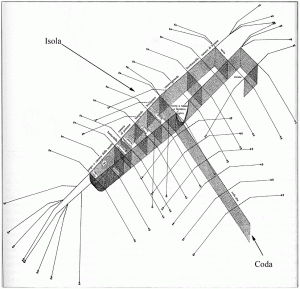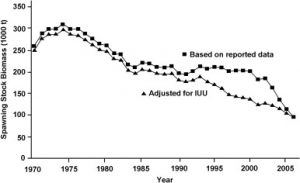The Overfishing of Mediterranean Bluefin Tuna
by Dani Escontrela, RJD Intern
Bluefin tuna is the most valuable fish species in the world. Their numbers, however, have greatly decreased in recent years due to their high demand. In fact, in 2001 “one 202 kilogram bluefin tuna caught off the northern coast of Oma, Japan sold at the Tsukiji market for 862 USD/kg” (Shamshak et al 2009). The bluefin tuna has life history traits that make it more susceptible to overfishing: they reproduce at a later age, they reproduce when they are of larger size, and they aggregate when they are going to spawn (Longo et al 2012). In addition, like many other species in the ocean, they are susceptible to industrial pollution. As the fishing of this species has continued without many regulations to protect them, their numbers have greatly declined. In fact the International Commission for the Conservation of Atlantic Tuna (ICAAT) predicts that a collapse in the fish stock in the near future is inevitable (Longo et al 2012).
Bluefin tuna used to be less valuable; in fact it wasn’t until recently that it became one of the most valuable fish species in the world. In the past, small communities along the Mediterranean were the ones that depended on it as a source of income and food. Traps such as “La Tonnara” which are used to “corral migrating bluefin tuna that come close to the Mediterranean shore before and/or after spawning” (Longo et al 2012) were used in a sustainable manner. These communities along the coast were lucky because the Mediterranean Sea contains one of two known spawning groups of Atlantic bluefin tuna in the world.

La Tonnara” was an artisanal trap used by many fishing towns along the Mediterranean to catch bluefin tuna at sustainable rates.
As time passed, technologies from other fisheries improved and were applied to the bluefin tuna fishery. These improved technologies allowed for better capture rates which increased the pressure on the bluefin tuna populations. In addition, it became less labor intensive to catch more fish. This led to the decline of artisanal traps and to the industrialization of the bluefin tuna fishery, allowing for mass harvesting of the fish in order to supply the world market (Longo et al 2012). The combination of improved technologies and its increasing status as a luxury food lead to larger demands worldwide; which has resulted in the declines of their population. In fact, the “spawning biomass has declined about 20-29 percent of 1970 levels” (Longo et al 2012).

: Spawning stock biomass of bluefin tuna. Numbers have consistently been declining since the 1970s and continue to decline today.
While this decrease of 20-29 percent of spawning stock biomass may not seem significant, the future of the bluefin tuna depends on these spawning groups to keep the population numbers up. If the number of spawning tuna keeps decreasing, their population could suffer even greater declines. If we want to keep depending on this fish as part of the global fish market, but more importantly if we want the fish to continue existing, we must start fishing at more sustainable rates.
It has been thought that one of the reasons the stocks have reached the levels they are at today is because it is “common property and has shared stock status” (Sumalia et al 2012). Although the ICAAT was set up in order to manage this problem of common property, they have consistently set quotas for catching the tuna at higher rates than what is recommended by scientists. Many ideas have been proposed in order to cope with the overfishing of the bluefin tuna, among these are the establishment of marine protected areas. In marine protected areas, human activity is monitored and restricted, this way animals passing through them have abundant food supplies and are safe from human activities. One of the reasons marine protected areas would be effective is because migration patterns of the bluefin tuna are well understood; because of this we know when and where they aggregate to spawn. Bluefin tuna are most vulnerable when they are spawning, if we set up marine protected areas at their spawning grounds the fishing pressures would be greatly decreased and would allow populations to recover (Sumalia et al 2012).
It has been proposed twice to list the bluefin tuna under CITES. It was first proposed by Sweden in 1992 but this petition was withdrawn. Later in 2010 Monaco petitioned for the fish to be listed under CITES; however, this petition got declined, in part due to “feverish rejection by some ICCAT member countries, in particular, Japan” (Sumalia et al 2012).
One solution to be looked at is the farming of bluefin tuna, which involves the “capture of wild seed-stock and their growout in sea pens” (Masuma et al 2008). This practice began in Japan in the 1970s and has spread throughout the world. In 1979, at the Fisheries Laboratory in Kinki University “research for rearing bluefin tuna larva began” and “5 year-old bluefin tuna broodstock were spawned in captivity for the first time in the world” (Masuma et al 2008). The farming of bluefin tuna has spread worldwide, especially in Mediterranean countries and Mexico. Although the farming of the fish have caused some problems such as environmental pollution and a reduction in the number of bluefin tuna, countries such as Japan are looking into the “strengthening of fishing regulations to reduce a catch of yearling bluefin tuna used for farming sea pens” (Masuma et al 2008). Another major problem with the farming of bluefin tuna is that an estimated 150,000 to 200,000 yearling are caught from the wild each year to support the stocks of farmed bluefin tuna. If we find a way to replace these wild fingerlings with artificial fingerlings, it would help conserve the wild fingerling populations. Recently “farms of the Kinki University have begun to harvest the artificial fingerling bluefin tuna every year, though still greatly depending on the wild seed-stock” (Masuma et al 2008). If we are able to perfect these farming practices, we could reduce a lot of the pressure we are creating for the wild bluefin tuna populations, and hopefully allow for their recovery.
REFERENCES:
Longo, Stefano B., and Brett Clark. “The Commodification of Bluefin Tuna: The Historical Transformation of the Mediterranean Fishery.” Journal of Agrarian Change 12.2-3 (2012): 204-26.
Masuma, Shukei, et al. “Status of Bluefin Tuna Farming, Broodstock Management, Breeding and Fingerling Production in Japan.” Reviews in Fisheries Science 16.1-3 (2008): 385-90.
Rashid, Sumalia Ussif, and Ling Huang. “Managing Bluefin Tuna in the Mediterranean Sea.” Marine Policy 36.2 (2012): 502-11.
Shamshak, Gina Louise, and James L. Anderson. “Dynamic Stochastic Adaptive BIioeconomic Model Of Offshore Bluefin Tuna Aquaculture.” Aquaculture Economics & Management 13.2 (2009): 155-75.




Trackbacks & Pingbacks
[…] Escontrela, D. The overfishing of mediterranean bluefin tuna. Retrieved April 29, 2014, from http://sharkresearch.rsmas.miami.edu/conservation/the-overfishing-of-mediterranean-bluefin-tuna […]
Leave a Reply
Want to join the discussion?Feel free to contribute!